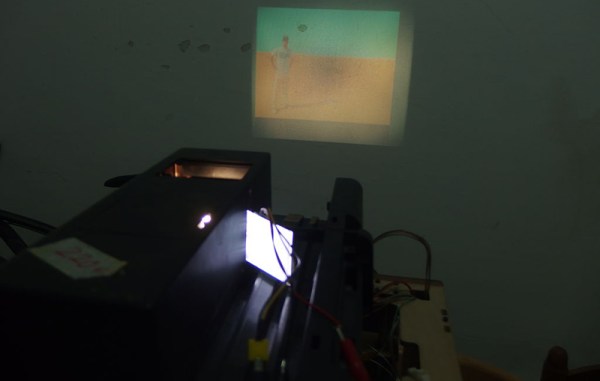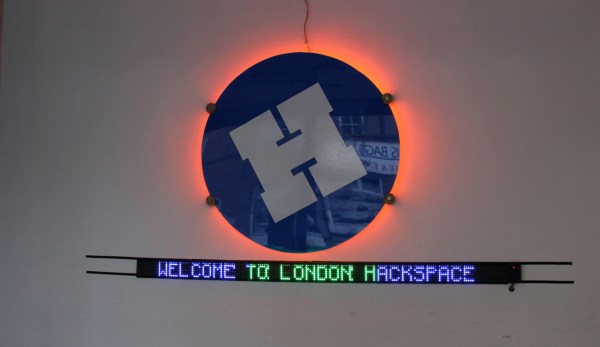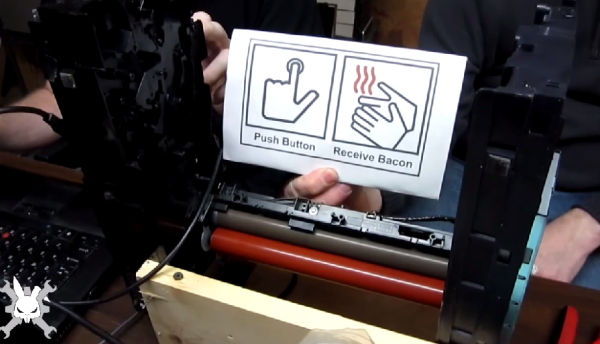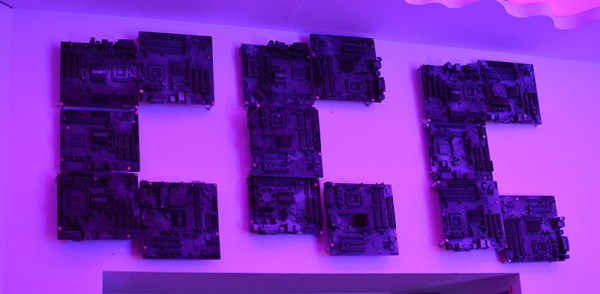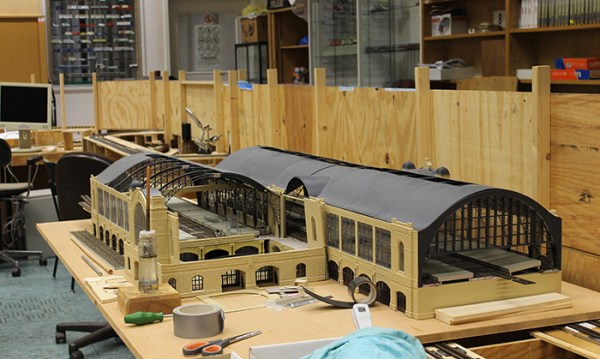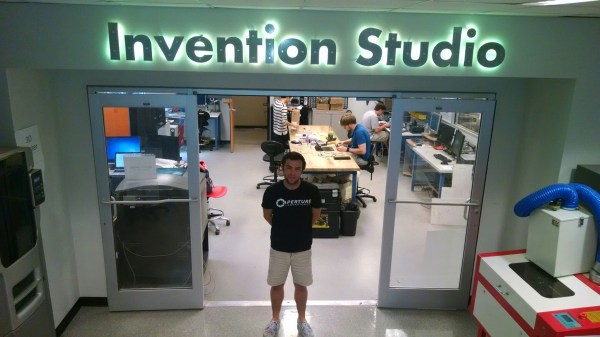Part of our whirlwind UK visit took us to Cambridge, where we had the joyous opportunity to check out Cambridge Makespace. The main space was formerly part of the Institute for Manufacturing Robot Lab at Cambridge University, so it has a long heritage of supporting engineering innovation. Continue reading “Hackerspace Tours: Cambridge Makespace”
Hackerspaces274 Articles
Cairo Hackerspace Gets A $14 Projector
The Cairo hackerspace needed a projector for a few presentations during their Internet of Things build night, and of course Friday movie night. They couldn’t afford a real projector, but these are hackers. Of course they’ll be able to come up with something. They did. They found an old slide projector made in West Germany and turned it into something capable of displaying video.
The projector in question was a DIA projector that was at least forty years old. They found it during a trip to the Egyptian second-hand market. Other than the projector, the only other required parts were a 2.5″ TFT display from Adafruit and a Nokia smartphone.
All LCDs are actually transparent, and if you’ve ever had to deal with a display with a broken backlight, you’ll quickly realize that any backlight will work, like the one found in a slide projector. By carefully removing the back cover of the display, the folks at the Cairo hackerspace were able to get a small NTSC display that would easily fit inside their projector.
After that, it was simply a matter of putting the LCD inside the display, getting the focus right, and mounting everything securely. The presentations and movie night were saved, all from a scrap heap challenge.
Hackerspace Tours: London Hackspace
On the way back from Hackaday Munich a couple of us got the chance to stop off in the UK, so we thought we’d take the opportunity to visit London Hackspace. With close to 1100 members and more than 6500 sq ft of space over two floors, it has to be one of the largest hackerspaces we’ve seen. [Russ Garrett] and [Jasper Wallis] were kind enough to show us around. Continue reading “Hackerspace Tours: London Hackspace”
Push Button, Receive Bacon.
Members of the Rabbit Hole hackerspace spent the last weekend competing in The Deconstruction, a 48 hour hackathon competition. The hackerspace’s theme was “Light it up!”, so members created some awesome projects involving light. The star of the show was their bacon cooking machine. The Rabbit hole made the “Push Button. Receive Bacon” meme real.
A broken laser printer was gutted for its drive train and fuser assembly. Laser printer fusers are essentially hot rollers. The rollers melt toner and fuse it with paper as it passes through the printer. The heat in this case comes from a lamp inside the roller. That lamp also puts out plenty of light, which fit perfectly with the team’s theme.
The Rabbit Hole members wasn’t done though, they also built a pocket-sized infinity mirror from an empty Altoids tin. The bottom of the tin was cut out, and a mirror glued in. A filter from a broken projector made a perfect half silver mirror, and some LEDs completed the project.
The members also built a fandom art piece, consisting of 25 fans connected together in a skull shape. The eye and nose fans were lighted. When the fans were plugged in, they kicked for a few seconds before spinning up. Once they did spin though – there was a mighty wind in the Rabbit Hole.
Click past the break for The Rabbit Hole’s Deconstruction video!
Hackerspace Tours: MuCCC
Our trip to Germany wouldn’t be complete without a trip to a proper European hackerspace, and the Munich Chaos Computer Club was more than accommodating in allowing us to invade their space.
Before even walking in the door, you’re greeted with one of the coolest displays you’ve ever seen. Half of the front of their building is a gigantic flipdot display. It’s astonishing in person, and although no dots were flipped during our visit, we can imagine the noise would be deafening. Simply awesome.
Walking in the door, you’re greeted with the general meeting area, conference room, couches, and a Twilight Zone pinball machine. The machine didn’t quite work when we arrived, but within five minutes, [Sprite_TM] was behind the backglass and had everything fixed within an hour.
The back room and basement have the usual assortment of tools – a 3D printer, CNC, lathe, and electronics workbench. If you need a key made, head to the basement. You’ll also find an ATM in the basement. The story with that is that the news station in Munich wanted to do a story on how easy it was to get USB access to the Windows system in an ATM. The station couldn’t do it – but they faked it – and put the ATM up on eBay. Not much money later, the ATM found its way to the space’s basement.
MuCCC is more than just a space with tools, though: in the european hackerspace tradition, there are frequent presentations and talks that would fit in at an academic conference. Last Tuesday, [nicolas] presented a few techniques to protect cryptographic keys from physical integrity attacks, i.e. an evil maid attack or a SWAT team invading your router closet. It’s a daemon that listens to an AVR loaded up with sensors through a GPIO pin. If there is physical intrusion in the device – barometric pressure or light – keys resident in memory can be erased.
You can check out a gallery of pics from the space below.
Because You Can’t Go To Germany Without Seeing Model Trains
As with all our extracurricular adventures, we needed to visit a few hackerspaces while in Munich. The first one was MCSM/Make Things Munich, formerly the Siemens Club for model engines. We’ve been to a few hackerspaces and have the passport stamps to prove it, and we can say without a doubt this space is unique.
MCSM was a hackerspace before the concept of hackerspaces existed. Originally, this was the Siemens Club for Model Engines, filled with engineers from the Siemens plant tinkering with model trains, model boats, and models of anything that moves. One of the members that guided us through the space, [Carlos Morra] told us when he joined, he alone dropped the average age of the space’s membership by a decade.
Inside the space, you’ll find the usual tools and equipment – lathes, CNC mills, an electronics workbench, and a bunch of old but still valuable equipment. Most of this equipment was salvaged from the Siemens plant. The organization for this space, though, cannot be compared to anything I’ve ever seen. There are floor to ceiling cabinets filled with everything you can imagine, all carefully indexed and sorted.
Of course, being formerly called the Model Engine club, there will be an immense train layout. I counted at least five gauges of track in two sprawling layouts, one of which was easily 15 square meters. It’s a true hackerspace built from a model train club, how can it get better than that?
Pictures below.
Continue reading “Because You Can’t Go To Germany Without Seeing Model Trains”
Adventures In Hackerspacing: GA Tech’s Invention Studio
We feature hacker/makerspaces of all kinds here at Hackaday, and these days, encountering a hackerspace at a college or university isn’t uncommon. School-backed spaces are often mildly impressive, too, with plenty of room and better-than-most equipment.
Georgia Tech’s Invention Studio, however, is different. This space is nothing short of staggering.
Once you’ve walked past the wall of commercial-grade 3D printers lining the entryway, you’ll find yourself in the Electro-lounge, a general meeting and hangout room with some basic tools. Each room beyond has a specific purpose, and is packed full of equipment. We aren’t just going on a tour, though, because this is Adventures in Hackerspacing. Click through the break for a behind-the-scenes look at how this hackerspace provides a top-rate experience for its makers and how Invention Studio thrives with an entirely student-run leadership.
Continue reading “Adventures In Hackerspacing: GA Tech’s Invention Studio”


